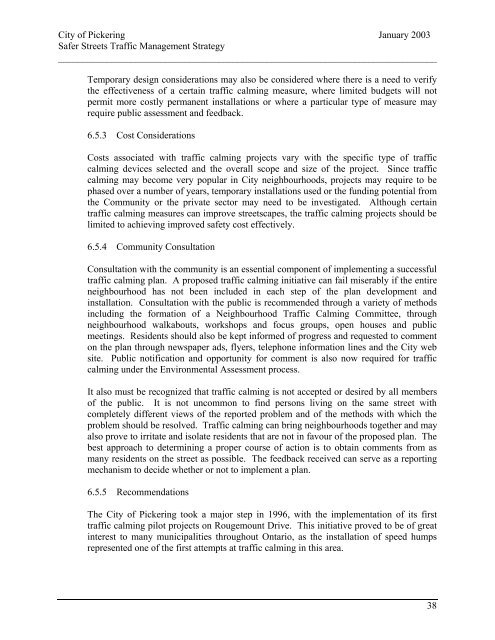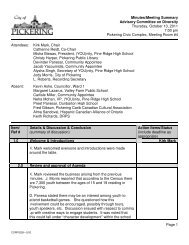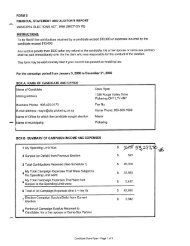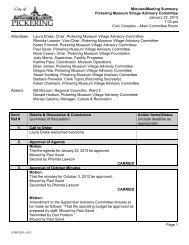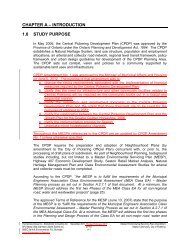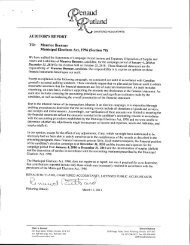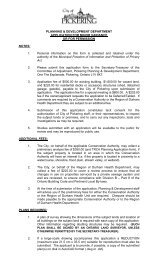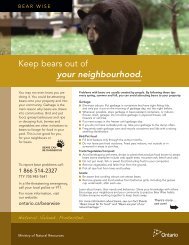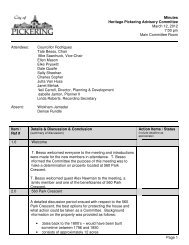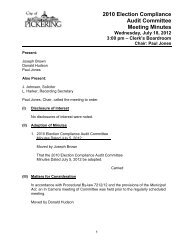foreword - City of Pickering
foreword - City of Pickering
foreword - City of Pickering
You also want an ePaper? Increase the reach of your titles
YUMPU automatically turns print PDFs into web optimized ePapers that Google loves.
<strong>City</strong> <strong>of</strong> <strong>Pickering</strong> January 2003<br />
Safer Streets Traffic Management Strategy<br />
______________________________________________________________________________<br />
Temporary design considerations may also be considered where there is a need to verify<br />
the effectiveness <strong>of</strong> a certain traffic calming measure, where limited budgets will not<br />
permit more costly permanent installations or where a particular type <strong>of</strong> measure may<br />
require public assessment and feedback.<br />
6.5.3 Cost Considerations<br />
Costs associated with traffic calming projects vary with the specific type <strong>of</strong> traffic<br />
calming devices selected and the overall scope and size <strong>of</strong> the project. Since traffic<br />
calming may become very popular in <strong>City</strong> neighbourhoods, projects may require to be<br />
phased over a number <strong>of</strong> years, temporary installations used or the funding potential from<br />
the Community or the private sector may need to be investigated. Although certain<br />
traffic calming measures can improve streetscapes, the traffic calming projects should be<br />
limited to achieving improved safety cost effectively.<br />
6.5.4 Community Consultation<br />
Consultation with the community is an essential component <strong>of</strong> implementing a successful<br />
traffic calming plan. A proposed traffic calming initiative can fail miserably if the entire<br />
neighbourhood has not been included in each step <strong>of</strong> the plan development and<br />
installation. Consultation with the public is recommended through a variety <strong>of</strong> methods<br />
including the formation <strong>of</strong> a Neighbourhood Traffic Calming Committee, through<br />
neighbourhood walkabouts, workshops and focus groups, open houses and public<br />
meetings. Residents should also be kept informed <strong>of</strong> progress and requested to comment<br />
on the plan through newspaper ads, flyers, telephone information lines and the <strong>City</strong> web<br />
site. Public notification and opportunity for comment is also now required for traffic<br />
calming under the Environmental Assessment process.<br />
It also must be recognized that traffic calming is not accepted or desired by all members<br />
<strong>of</strong> the public. It is not uncommon to find persons living on the same street with<br />
completely different views <strong>of</strong> the reported problem and <strong>of</strong> the methods with which the<br />
problem should be resolved. Traffic calming can bring neighbourhoods together and may<br />
also prove to irritate and isolate residents that are not in favour <strong>of</strong> the proposed plan. The<br />
best approach to determining a proper course <strong>of</strong> action is to obtain comments from as<br />
many residents on the street as possible. The feedback received can serve as a reporting<br />
mechanism to decide whether or not to implement a plan.<br />
6.5.5 Recommendations<br />
The <strong>City</strong> <strong>of</strong> <strong>Pickering</strong> took a major step in 1996, with the implementation <strong>of</strong> its first<br />
traffic calming pilot projects on Rougemount Drive. This initiative proved to be <strong>of</strong> great<br />
interest to many municipalities throughout Ontario, as the installation <strong>of</strong> speed humps<br />
represented one <strong>of</strong> the first attempts at traffic calming in this area.<br />
38


